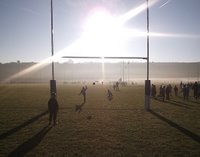This is a special post for teachers and students of the OCR A/AS-level exam specification in the UK. We were particularly attracted to the OCR specification because it includes the unique 'core studies' unit which revisits classic studies from across the breadth of the psychology.
Below we collect together some key resources from the Research Digest and The Psychologist magazine (shown in red throughout post) relevant to the studies from the new specification, which teachers are currently preparing to teach from September 2008.
We’ve also contacted some of the authors of these ‘core studies’ for their views on influences, reactions, and how their research has stood the test of time.
1. LOFTUS, E. & PALMER, J. (1974). Reconstruction of automobile destruction. Journal of Verbal Learning and Verbal Behaviour, 13, 585-589.
Elizabeth Loftus: "I had been studying semantic memory for several years when I decided I wanted to do some work that had more obviously social relevance. A perfect place to go for someone with a background in memory and an interest in legal matters was the study of eyewitness memory.
The particular angle I took was to look at the impact of leading questions. With collaborators, I showed that a leading question could affect the answer a witness gave. This is something lawyers and psychologists had known, but we showed that changing even a single word in a question could make a dramatic difference. However, we went further in this research in showing that a leading question could have a longer-range effect – it could influence the answers that witnesses gave to completely different questions posed much later. And it was my first inkling that the leading questions might actually be altering a witness’s memory.
Why did I study memory for accidents? A former professor of mine from Stanford was now working for the United States Department of Transportation. He said that there was money for research on accidents. So I wrote a proposal to look at leading questions and memory for accidents, and got my first big research grant. Of course the conclusions apply to myriad forms of complex autobiographical memory, but this is why these particular subjects were looking at accidents rather than some other stimuli.
The title, ‘Reconstruction of Automobile Destruction’, came to me while talking to a colleague at the Xerox machine. It seemed pithy and perfect. However, later I would get reprint requests from people who were expecting to learn about the engineering aspects of accident reconstruction!"
BPS resources: Loftus on false memories ; False memories about fattening foods ; Earwitness testimony .
2. BARON-COHEN, S., JOLLIFFE, T., MORTIMORE, C. and ROBERTSON, M. (1997). Another advanced test of theory of mind: evidence from very high functioning adults with autism or asperger syndrome. Journal of Child Psychology and Psychiatry, 38, 813-822.
Simon Baron-Cohen: "The inspiration for the Eyes test was five-fold:(1) In the early 90s we had published a series of papers showing that mental states are not unobservable (which was the traditional view) but had some outward markers (e.g. facial expression, vocal intonation). Darwin had thought this might be restricted to the 'basic' emotions (happy, sad, angry, afraid, and surprised), but we wanted to see if even the 'complex' mental states (such as reflective, or distrust) might also be ‘readable’ from the face; (2) the traditional 'theory of mind' tests were all-or-none (pass/fail) tests which did not allow for the measurement of individual differences; (3) one type of individual difference that we wanted to test was a sex difference (given the widespread view in our society that empathy is better in females) but this needed a test that might be sensitive to individual differences of a subtle nature; and (4) there was a need for an ‘advanced’ theory of mind test because most of the available ones were designed for children. This meant that it was impossible to say if an adult had 'normal' theory of mind simply because they could pass a child-level test. What was needed was an age-appropriate adult-level test; (5) there was a need for a test of theory of mind that was not just relevant to the lower functioning individuals with autism but also to the higher functioning individuals with autism (such as Asperger Syndrome) if we were to test if a theory of mind deficit was universal to all individuals on the autistic spectrum.
What has been a pleasant surprise is how this test has been rapidly picked up by researchers across the world studying different clinical conditions or to test correlates of social cognition, across different cultures. I like to think that is because it is recognised as ecologically valid: that we do indeed pick up important information about a person's mind from subtle cues around their eyes. And that variation in such a skill might be both universal to humans, and be in part influenced by our biology (our genes or our hormones), such that atypical performance on this test could be the result of atypical neural structure or function."
BPS Resources: How children with autism draw people ; Feeling other people's pain ; Autism and theory of mind .
3. SAVAGE-RUMBAUGH, S. (1986). Spontaneous Symbol Acquisition and Communicative Use by Pygmy Chimpanzees. Journal of Experimental Psychology General, 115(3), 211-35.
BPS Resources: The usefulness of research on animals ; and debate here ; research on language .
1. SAMUEL, J. & BRYANT, P. (1984). Asking only one question in the conservation experiment. Journal of Child Psychology and Psychiatry, 25, 315-318.
NO RESOURCES AS YET – watch this space!
2. BANDURA, A., ROSS, D. & ROSS, S. (1961). Transmission of aggression through imitation of aggressive models. Journal of Abnormal and Social Psychology, 63, 375-382.
NO RESOURCES AS YET – watch this space!
3. FREUD, S. (1909). Analysis of a phobia of a five-year old boy. Pelican Freud Library. Vol. 8. Case Histories 1.
BPS Resources: What did Freud get right? Freud's influence .
1. Maguire, E.A., Gadian, D.G., Johnsrude, I.S. et al. (2000). Navigation-related structural changes in the hippocampi of taxi drivers. Proceedings of the National Academy of Science, USA, 97, 4398–403.
Eleanor Maguire: "The taxi driver study was inspired not so much by one previous paper, but by a whole set. For many years work in non-humans (birds, small mammals) suggested that animals who were particularly reliant on having a good spatial memory (for food-storing, or with large territories) had a larger hippocampus, even when body and brain size were taken into account. Even more interesting was the finding that hippocampal volume could change depending on the season! So during mating season in some species, when animals would wander far and wide, hippocampal volume would increase. This led me to wonder if similar kinds of effects could be found in humans; could the volume of the human hippocampus change in response to navigation needs.The original taxi driver study received global interest from fellow scientists, the media, and the general public. It really struck a chord, and to this day I still receive many inquiries about the study and subsequent work. I think its appeal lies in the ease with which the message can be understood by non-experts, but also in the important implications it has for scientists who study the cognitive neuroscience of memory."
BPS resources: None as yet – watch this space!
The research won Maguire and her team the ‘IgNobel’ award, which honour people whose achievements ‘cannot or should not be reproduced’. See here and here.
2. DEMENT, W. & KLEITMAN, N. (1957). The relation of eye movements during sleep to dream activity. Journal of Experimental Psychology, 53(5), 339-346.
BPS Resources: Sleep and memory consolidation ; Sleep and electrical stimulation ; Sleep .
3. SPERRY, R. (1968). Hemisphere deconnection and unity in consciousness. American Psychologist, 23, 723-733.
BPS Resources: The corpus callosum ; Hemispheric specialisation and brain state ; Seeing half the world through the prism of language .
1. MILGRAM, S. (1963). Behavioural study of obedience. Journal of Abnormal and Social Psychology, 67, 371-378.
See also Wikipedia entry, with links.
BPS Resources: Milgram reproduced in virtual reality.
2. REICHER, S. & HASLAM S.A. (2006). Rethinking the psychology of tyranny. The BBC prison study. British Journal of Social Psychology, 45, 1-40.
The BBC Prison Study has its own resource-packed website. Psychblog has links to several videos about Zimbardo's Stanford Prison Study, including a BBC interview with the man himself.
Alex Haslam: "Our study was, of course, inspired by the Stanford Prison Experiment (Haney et al., 1973). However, we and others had always felt that this study (and the theory that informed it) was limited because it failed to explore processes of resistance as well as those of tyranny. In line with the basic principles of social identity theory (Tajfel & Turner, 1979), we were therefore influenced by research like that of Wright et al. (1998) which showed that, under certain conditions, individuals would come together as a group to protest unfair treatment and in order to bring about social change. We were surprised by Zimbardo's argument that, because the BBC study showed that under particular conditions prisoners resist inequality, this must be the result a design error. Moreover, he argued that such resistance (and the stress it caused the guards) was evidence that our study lacked external validity since ‘such events [are unheard of] in any real prison anywhere in the known universe’. In fact though, the criminology literature discusses a number of classic cases of such resistance (e.g., Buntman, 2003; McEvoy, 2001), and also indicates that prison staff typically experience high levels of burnout and alienation (Phillber, 1987). The point is that both tyranny and resistance occur in prisons (as in other social systems), and the task of social psychology is to explain when and why these different outcomes occur."
Steve Reicher: "Historically, the Stanford Prison study was critical in turning the tide against personality explanations of (extreme) social behaviour and in demonstrating the power of context. But Zimbardo’s one-dimensional situationism in turn was bleak and unconvincing. It suggests that, particularly in groups, we cannot help but succumb to the demands placed upon us — that as social beings we have no agency, no choice and hence no responsibility for what we do. That is how Zimbardo explains and excuses the behaviour of the Stanford Guards. It comes as no surprise that, more recently, Zimbardo has played a prominent role in defending some of the soldiers accused of abuses at Abu Ghraib.
Where we strongly endorse Zimbardo’s contribution is in the need for a group-level explanation of brutality and inhumanity. Where we differ is in the type of group processes that are involved. More specifically, we strongly dispute the notion that group psychology is inherently primitive and negative.
Our own results, in accord with other work in the social identity tradition (e.g., Turner et al., 1987, 1994), show this clearly. First, our Guards and Prisoners did not automatically and helplessly slot into their assigned roles. Rather, their willingness to act as group members depended upon their identification with the group. Identification, in turn, was a function of the opportunities they perceived in the immediate context and the consequences they imagined in future contexts.
Second, shared identification was critical for people to work together and achieve their goals. It led to trust, to coordination, to planning and to the emergence of consensual leadership. In all these ways, group membership allowed people to become the authors of their own fate rather than have their fate imposed by others.
Third, while groups can of course do terrible things, this is not a function of some inherent flaw in group psychology, but rather stems from the social belief systems that inform group behaviour. The solution therefore lies at a societal and ideological level. Contrary to Zimbardo’s suggestions, it certainly does not lie in trying to break down the group and getting people to behave as individuals. Indeed there is a grave danger in following that path — not least because it is only in groups that people can resist oppression. Moreover, one of the most surprising and most disturbing findings in our study was that, when their own groups fail and people are unable, collectively, to build a system based on their own values, then these people will become more prone to let others build a system for them, even if it is based on completely alien values. It was this which led our participants to become increasingly authoritarian during the study and to turn increasingly from democracy to an embrace of tyranny (Haslam & Reicher, 2007a; Reicher & Haslam, 2006a).
In some quarters, our criticisms of Zimbardo’s brand of situationism have been taken as support for a return to some sort of personality explanation. They are not. Our argument is precisely that we need to overcome the old opposition between individual and situation — or, more accurately, between individual and group — and understand how these two things are informed by, and structure, each other (Haslam & Reicher, 2007b).
One of the moist basic messages to be taken from our study is that people are not mindless in groups. They do not follow norms or role requirements like mindless robots. Rather the group provides both (a) an intellectual framework for members to discuss and debate what is appropriate for them to do, and (b) the practical power to turn words into deeds. That is (in contrast to Zimbardo) we show that groups allow for, rather than detract from, human agency, choice and responsibility (Reicher & Haslam, 2006b). The challenge for the next wave of social psychological theory is to unravel the nature of this interdependency between individuality and collectivity."
BPS Resources: Tyranny revisited: The BBC Prison Study ; Zimbardo reassessed ; Can good people really turn bad?
3. PILIAVIN, I., RODIN, J. & PILIAVIN, J. (1969) Good Samaritanism; an underground phenomenon? Journal of Personality and Social Psychology, 13(4), 289-299.
BPS Resources: Altruism ; The bystander phenomenon revisited .
ROSENHAN, D. (1973). On being sane in insane places. Science, 197, 250-258.
BPS Resources: Paranoia in the Digest ; and The Psychologist .
THIGPEN, C. & CLECKLEY, H. (1954) A case of multiple personality. Journal of Abnormal and Social Psychology, 49, 135-151.
BPS Resources: The human chameleon ; Multiple personality and child abuse .
GRIFFITHS, M.D. (1994). The role of cognitive bias and skill in fruit machine gambling. British Journal of Psychology, 85, 351-369. Listen to podcast
Mark Griffiths: "As a new PhD student, the paper that really inspired me was a pioneering study by Anderson and Brown (1984). Much of the experimental work on the psychology of gambling had been done in laboratory settings and the question of ecological validity was something that I had great concerns about. I didn’t want to study gamblers in a psychology laboratory, I wanted to examine them in the gambling environments themselves. Anderson and Brown studied a group of regular gamblers and reported that their heart rates did not increase in laboratory conditions but did in field conditions (i.e. in the casino), by an average of 23bpm. This perhaps explained why studies on arousal during laboratory gambling had failed to find heart rate increases above baseline levels.From this study, Anderson and Brown – unhappy that Skinnerian reinforcement theory could not account for the phenomenology of pathological gambling (especially relapse after abstinence) – postulated a model centering upon individual differences in cortical and autonomic arousal in combination with irregular reinforcement schedules. This neo-Pavlovian model in which arousal has a central role, plays an important role in the addiction process. According to Anderson and Brown, this model accounts for reinstatement after abstinence and allows for the maintenance of the behaviour by internal mood/state/arousal cues in addition to external situation cues.
My 1994 study raised lots of interesting points and by studying gamblers within session I obtained lots of interesting data. One of the more interesting observations concerned ‘the psychology of the near miss’. I noticed that when thinking aloud, regular gamblers often explained away their losses and changed clear losses into near winning ones (i.e., gamblers weren’t constantly losing, they were constantly nearly winning, and this was both psychologically and physiologically rewarding for them). The work of Paul Delfabbro in Australia built on my idea of analyzing gamblers within session and postulated that gambling is maintained by winning and losing sequences within the operant conditioning paradigm (i.e. that the only rewards and reinforcers in gambling are purely monetary). I then argued in a follow up paper (Griffiths, 1999) that Delfabbro and Winefield’s contribution was too narrow in its focus in that they had taken no account of the "near miss" in relation to operant conditioning theory and that there may be other reinforcers that play a role in the maintenance process. I also argued that gambling was biopsychosocial behaviour and should therefore be explained by a biopsychosocial account.
I think the study is important because it showed that gamblers could be studied in real-life contexts and that useful data could be collected. It also showed the complexity of gambling and that gamblers could turn apparently objective outcomes (losing) into ones that were highly subjective (near winning ones). I also showed that this had implications for treatment (see Griffiths, 1993a). I also argued that this was just one part of a big jigsaw and that this one study shouldn’t be seen in isolation but read along with my observational studies (Griffiths, 1991a), my other experimental studies in an arcade examining heart rate arousal (Griffiths, 1993b; 1995), my semi-structured interview studies (Griffiths, 1990), surveys (e.g. Griffiths, 1993c), and my case studies (Griffiths, 1991b; Griffiths, 1993). All of these studies as a whole were featured in my first book (Griffiths, 1995b)."
BPS Resources: Griffiths’s ‘action plan’ on problem gambling.
--
Thanks to Dr Jon Sutton who helped compile all these links and comments.


















